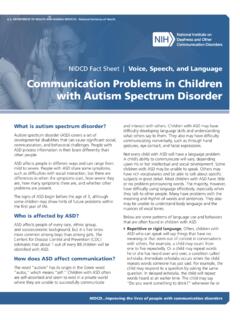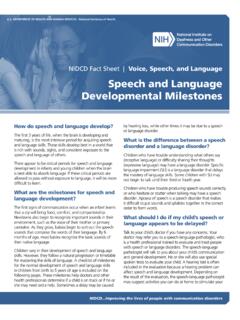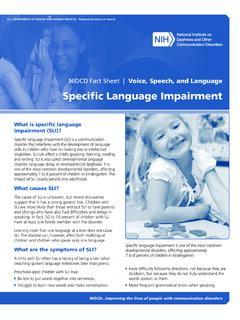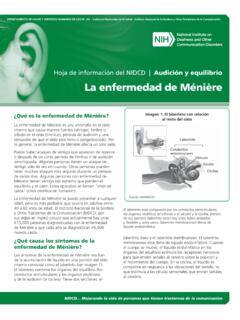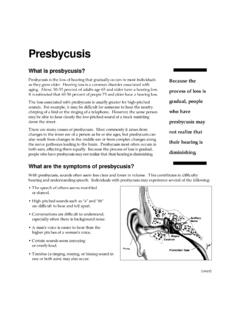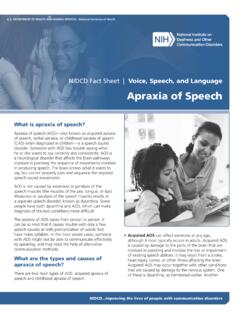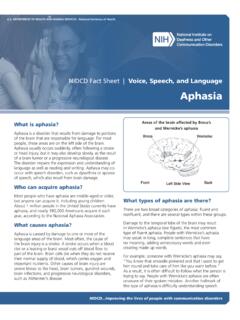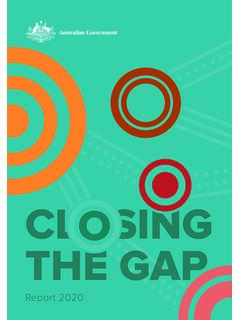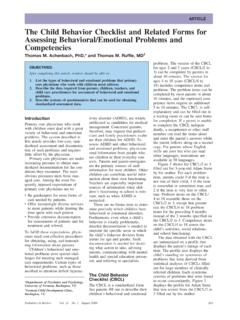Transcription of Autism Spectrum Disorder: Communication Problems in …
1 DEPARTMENT OF HEALTH AND HUMAN SERVICES National Institutes of HealthNIDCD Fact Sheet | Voice, Speech, and LanguageAutism Spectrum Disorder: Communication Problems in ChildrenWhat is Autism Spectrum disorder? Autism Spectrum disorder (ASD) is a developmental disability that can cause significant social, Communication , and behavioral challenges. The term Spectrum refers to the wide range of symptoms, skills, and levels of impairment that people with ASD can have. ASD affects people in different ways and can range from mild to severe. People with ASD share some symptoms, such as difficulties with social interaction, but there are differences in when the symptoms start, how severe they are, the number of symptoms, and whether other Problems are present.
2 The symptoms and their severity can change over behavioral signs of ASD often appear early in development. Many children show symptoms by 12 months to 18 months of age or is affected by ASD?ASD affects people of every race, ethnic group, and socioeconomic background. It is four times more common among boys than among girls. The Centers for Disease Control and Prevention (CDC) estimates that about 1 in every 54 children in the has been identified as having does ASD affect Communication ?The word Autism has its origin in the Greek word autos, which means self.
3 children with ASD are often self-absorbed and seem to exist in a private world in which they have limited ability to successfully communicate and interact with others. children with ASD may have difficulty developing language skills and understanding what others say to them. They also often have difficulty communicating nonverbally, such as through hand gestures, eye contact, and facial expressions. The ability of children with ASD to communicate and use language depends on their intellectual and social development. Some children with ASD may not be able to communicate using speech or language, and some may have very limited speaking skills.
4 Others may have rich vocabularies and be able to talk about specific subjects in great detail. Many have Problems with the meaning and rhythm of words and sentences. They also may be unable to understand body language and the meanings of different vocal tones. Taken together, these difficulties affect the ability of children with ASD to interact with others, especially people their own age. Below are some patterns of language use and behaviors that are often found in children with ASD. }Repetitive or rigid language. Often, children with ASD who can speak will say things that have no meaning or that do not relate to the conversations they are having with others.
5 For example, a child may count from one to five repeatedly amid a conversation that is not related to numbers. Or a child may continuously repeat words he or she has heard a condition called echolalia. Immediate echolalia occurs when the child repeats words someone has just said. For example, the child may respond to a question by asking the the lives of people with Communication disorders2same question. In delayed echolalia, the child repeats words heard at an earlier time. The child may say Do you want something to drink? whenever he or she asks for a drink.
6 Some children with ASD speak in a high-pitched or sing-song voice or use robot-like speech. Other children may use stock phrases to start a conversation. For example, a child may say, My name is Tom, even when he talks with friends or family. Still others may repeat what they hear on television programs or commercials. }Narrow interests and exceptional abilities. Some children may be able to deliver an in-depth monologue about a topic that holds their interest, even though they may not be able to carry on a two-way conversation about the same topic. Others may have musical talents or an advanced ability to count and do math calculations.
7 Approximately 10 percent of children with ASD show savant skills, or extremely high abilities in specific areas, such as memorization, calendar calculation, music, or math. }Uneven language development. Many children with ASD develop some speech and language skills, but not to a normal level of ability, and their progress is usually uneven. For example, they may develop a strong vocabulary in a particular area of interest very quickly. Many children have good memories for information just heard or seen. Some may be able to read words before age five, but may not comprehend what they have read.
8 They often do not respond to the speech of others and may not respond to their own names. As a result, these children are sometimes mistakenly thought to have a hearing problem . }Poor nonverbal conversation skills. children with ASD are often unable to use gestures such as pointing to an object to give meaning to their speech. They often avoid eye contact, which can make them seem rude, uninterested, or inattentive. Without meaningful gestures or other nonverbal skills to enhance their oral language skills, many children with ASD become frustrated in their attempts to make their feelings, thoughts, and needs known.
9 They may act out their frustrations through vocal outbursts or other inappropriate are the speech and language Problems of ASD treated?If a doctor suspects a child has ASD or another developmental disability, he or she usually will refer the child to a variety of specialists, including a speech-language pathologist. This is a health professional trained to treat individuals with voice, speech, and language disorders . The speech-language pathologist will perform a comprehensive evaluation of the child s ability to communicate, and will design an appropriate treatment program.
10 In addition, the speech-language pathologist might make a referral for a hearing test to make sure the child s hearing is children with ASD to improve their Communication skills is essential for helping them reach their full potential. There are many different approaches, but the best treatment program begins early, during the preschool years, and is tailored to the child s age and interests. It should address both the child s behavior and Communication skills and offer regular reinforcement of positive actions. Most children with ASD respond well to highly structured, specialized programs.
